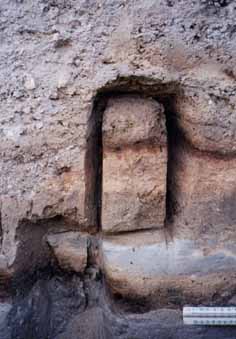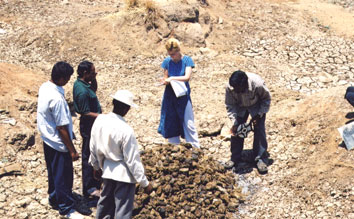The Bellary District Archaeological
Project

|
The Bellary District Archaeological Project |
 |
| Geoarchaeology
of Ashmounds |
|
Another feature of the ashmound investigation was the creation of a small ashmound through experimental burning of cowdung. This experimentation allowed us to consider the processes of ashmound formation, and to record and investigate the physical outcome of specific dung burning and trampling practices. Two trials were conducted. In the first, we attempted to set on fire a large pile containing several cartloads of dung purchased from a local farmer who had gathered the material to apply to his fields. This trial was unsuccessful, however, since due to the inclusion of soil and cultural material (i.e. rubbish) within the manure, the dung mound would not ignite. A second trial was thus initiated, using pure, dried dung collected from surrounding fields. In this trial, ignition was successful, and the dung was converted to ash. The ash was subsequently trampled, and then a new load of dung was added and burnt. This sequence of dung collection, piling, burning, cooling and trampling was carried out three times, and the mound was then sectioned, drawn and sampled. The findings of this experiment will be discussed with reference to the Neolithic ashmounds in a future paper. |
 Extracting
intact sample of Kupgal
ashmound for micromorphological analyis The geoarchaeological element of the Bellary district project was given high priority when it was realised that ashmounds are currently being destroyed at a very rapid rate in south India (Protection of sites and monuments). Their recording and analysis are thus urgently required. Soil micromorphological thin sections from ashmounds, which allow microscopic analysis of ashmound components in their original stratigraphic context, will provide an important record and on-going resource after ashmound destruction. Two of the three ashmounds (Kupgal and Toranagallu) investigated will likely be fully destroyed within the next five years (see photo at right). Kudatini, despite being probably the largest ashmound in the southern Deccan, is also being slowly destroyed due to activities by the Public Works department.  Experimental burning of cattle dung |
|||
 |
 |
|||